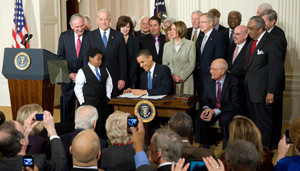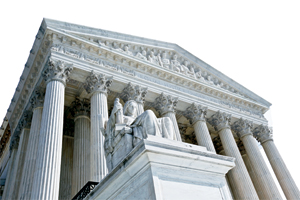CQ WEEKLY – COVER STORY
March 17, 2012 – 11:44 a.m.
Health Care’s Days in Court
By Gail Sullivan and Fred Barbash, CQ Staff
As the Supreme Court prepares to hear oral arguments in the health care case next week, each side has its own version of the law at issue, and they don’t look much alike.

|
||
|
There’s no “individual mandate” in the government’s brief to the court. It’s a “minimum coverage provision.” And no one is penalized for not buying insurance. Rather, they face “adverse tax consequences” for attempting to “self-insure.”
The parties challenging the law, by contrast, have built their argument around the mandate, which, plain and simple, “forces individuals to obtain insurance.” They call the administration’s portrayal “euphemistic,” at best.
Big court cases, like big political campaigns, sometimes come with competing narratives designed, often, to square their arguments with the court’s precedents or, in the case of the states and others that sued to defeat the law, to distinguish the law from a line of precedents that support the constitutionality of America’s regulatory state.
But the divergence of narrative in the health care cases is particularly sharp, perhaps because no prior case has been quite like this one. Basically, the government wants the law to seem normal, as if there were nothing much to make it stand out from laws that have been upheld in the past. Those suing to defeat the health care law want it to look deviant.
As the government sees it, no one is being forced to get coverage. Everyone already has coverage — even if they don’t know it. If they get hit by a truck, for example, they’ll be treated whether or not they have insurance.
They’re covered, all right. They’re just not paying for it. And that’s all the law does. It makes them pay in advance for what they already have.
That’s the gist of the Obama administration’s portrayal of the health care law to the Supreme Court. The law is unique, they argue, because it involves health care, which sooner or later everyone needs. That’s not true of much else.
By this argument, there’s no merit to critics’ slippery-slope claims that if the court upholds the law, there will be no end to what Congress can make Americans buy — broccoli being the most oft-cited example. Nobody, as a matter of life and death, needs broccoli. Nor is it customary to insure ourselves against future broccoli-related contingencies.
The states that sued to block the law just “imagine various ‘mandates,’” the government says, and are “‘conjuring up horrible possibilities that never happen in the real world.’” The alleged conjurers, in this instance, are the 26 states, led by Florida, the National Federation of Independent Business, and a handful of individuals who filed suit to stop the mandate.
Dragged Into the Stream?

|
||
|
Health Care’s Days in Court
In the challengers’ briefs on the central issue, the “individual mandate” is used almost exclusively. What it does, they say, is drag people into the insurance market who don’t want to be there. While the Constitution’s Commerce Clause permits the government to regulate the “stream of commerce,” it does not allow the government to march people into the stream in order to regulate them.
One thing both sides agree on is that the cases, collectively known as “the health care case,” are among the most important in modern history.
But of course, the court knows that. And the justices will be reminded of it when they show up next Monday and see throngs of activists sent to spin the press outside while the lawyers are busy inside.
It’s a kind of constitutional carnival, and it will last a total of six hours, over three days, rather than the usual single hour per case allotted by the court.
After all, the justices have not been sequestered for the past three years. By now, they’ve read the briefs, quite possibly know how they are likely to vote, and are not immune to their own ideological and political inclinations. For some of them, the oral arguments may not matter. If the justices are generous, a lawyer might get a full sentence out before being interrupted.
The lawyers will struggle to stay on message. Like politicians, they rely on “framing” to present their case in the best light, offering dire predictions of what might happen if the court goes the wrong way.

|
||
|
Critics say that if the court doesn’t strike down the law, there will be no limits to Congress’ power. “The mandate forces individuals to purchase insurance. . . . The implications of Congress’ newly minted theory of its commerce power are breathtaking.”
The government, in turn, suggests in its briefs that a wrong decision will raise questions about the court’s power.
“Congress enacted the Affordable Care Act and chose to include the minimum coverage provision after years of careful consideration and after a vigorous national debate,” Solicitor General Donald B. Verrilli, Jr., told the court. “That was a policy choice the Constitution entrusts to the democratically accountable branches to make, and the court should respect it.”
Into each narrative, the lawyers must somehow fit the court’s relevant cases.
An Ohio farmer named Roscoe Filburn is the poster child for the notion that choices about personal matters, such as how to feed or care for oneself, have an impact on interstate commerce. Filburn was fined for exceeding a New Deal-era quota on wheat production, although the extra he was growing was for his own use. Filburn argued that the fine was unfair — the personal wheat had nothing to do with the commercial market.
In 1942, in Wicker v. Filburn, the court agreed with the government, citing the cumulative effect of self-producing farmers such as Filburn on the demand for wheat purchased in the marketplace.
Health Care’s Days in Court
The wheat “supplies a need of the man who grew it, which would otherwise be reflected by purchases in the open market,” Justice Robert H. Jackson wrote in the opinion. “Home-grown wheat in this sense competes with wheat in commerce.”
In the health care case, the government and the parties attacking the law have, in briefs and in lower-court oral arguments, portrayed a Farmer Filburn-type figure — a hypothetical class of people sitting at home minding their own business, without health insurance policies.
In the challengers’ version of the story, the uninsured are forced to buy a commercial product that they don’t want and that the government has no business requiring of them.
According to the government, this case isn’t about the requirement to buy, it’s about the failure to pay.
To read some of the commentary on the case, it would appear that a lot of court watchers think they know which version of the story the justices will buy, based mostly on guesswork and conventional classifications — conservative, liberal, swing.
Ideologically, though, this may be a tricky case. Conservative justices who might find the law constitutionally repugnant, for example, are also avowed champions of judicial deference to the decisions of the elected branches and of the principle that the court should reach constitutional issues only when all else fails.
Indeed, they could avoid it entirely, at least for the time being, by deciding that a law that bars courts from hearing tax cases until the IRS tries to collect applies to the health care case. A lower court took that position because the penalty for not being insured takes the form of a tax. The court will hear that argument on the first day.
The court will also hear arguments on whether the law’s expansion of the Medicaid program to help finance the law infringes on the rights of states.
If the court does invalidate part of the law, it will also decide whether the entire statute must fall with it, or if the flawed section is “severable.”
No opinions are expected until June.
FOR FURTHER READING: State Medicaid programs, 2011 CQ Weekly, p. 1362; legal challenges, p. 292; enactment, 2010 Almanac, p. 9-3; provisions, p. 9-6.